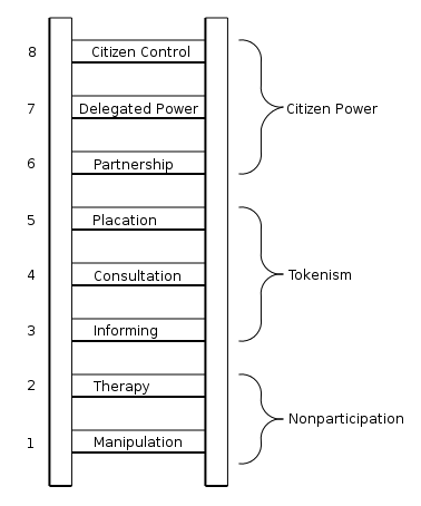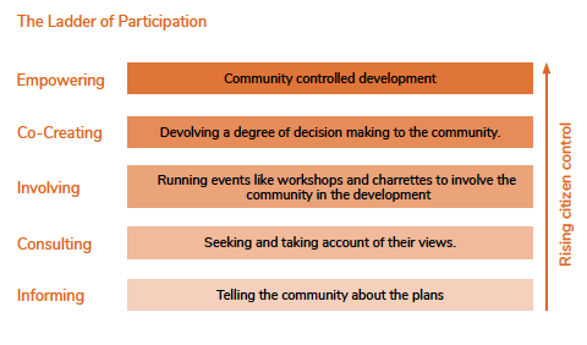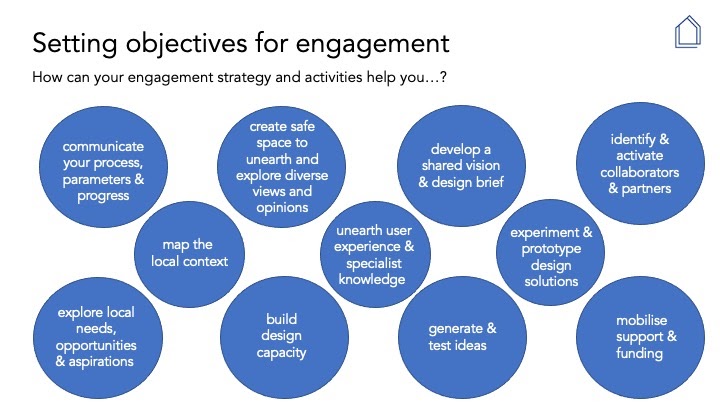Written by:
Most of us who work in the field of placemaking are familiar with Sherry Arnstein’s Ladder of Citizen Participation, which emerged from a piece she wrote about the planning system in the US back in 1969. It has become a point of reference that has been revered, challenged and reinterpreted in both practice and research, and in the context of placemaking, is considered an important tool in helping to explore the many facets of engaging people in processes to shape their environments.

Arnstein’s ladder marked the key levels of participation on the journey towards citizen power and control, and aimed to help those developing processes that involved citizens take a realistic look at where their processes sat on that continuum.
I was interested to see another iteration of the ladder in the recently published Quality of Life Framework, developed by The Quality of Life Foundation (QoLF) with Urbed and the support of the QoLF network of associates and partners, which offers an interesting and challenging new take on development through the lens of improving people’s quality of life. I was pleased to play a very small role in shaping the framework and strongly recommend you take a look at it, if you have not yet done so.
The Framework’s version of the Ladder of Participation describes the top rung of the ladder in the context of placemaking as community controlled development, and as the final empowering rung of the ladder.

This piqued my interest and gave me pause to think.
At The Glass-House, we champion and enable what we refer to as empowering design processes, and are interested in the interplay of empowering people to and through design. This begins with empowering people with the tools and confidence to take part in or lead a design process. However, we have seen, and indeed built an extensive research project (Empowering Design Practices) around the role that taking part in a design process to shape local places can play in creating empowerment opportunities that extend far beyond the confines of a placemaking project itself, building confidence, skills, relationships, and ultimately social capital and social cohesion.
So when I looked at this illustration of empowerment at the top of their ladder of participation, it brought me back to the discomfort I have always felt in the common interpretation and simplification of the top rung being the ultimate goal and what falls below it as not hitting the mark. When we are talking about the complex layers and levels of empowerment opportunity within a participatory design process in placemaking, the ladder feels useful in framing and assessing individual activities, but we need something else to help us think about how those activities fit together to form an effective community or citizen engagement strategy.
So I propose the notion of a tapestry of participation.
This begins with the premise that various rungs of the ladder, whether of Arnstein’s original version or the many iterations that have since emerged and evolved, have their place in an effective community engagement strategy and can create opportunities to empower people. The important thing is to understand and recognise what opportunities those different rungs offer both in terms of empowering local people, and in terms of driving design decision-making.
I confess that we at The Glass-House used to look upon the term and practice of consultation with disdain and in a running in-house joke, referred to it as “the c word” in empowerment terms. However, we came to realise that consultation has its value if its intentions are clear, its limitations are recognised, and its outputs used transparently. On its own, it can only achieve so much, but if seen as part of a tapestry of engagement methods, it too deserves a place at the table.
We began to unpick what different methods for enabling community participation and leadership in design and placemaking could achieve and how when woven together, they contribute to the empowerment agenda. In working with both communities and with practitioners, we have developed a range of resources to help people explore how they can both lead and get involved in transforming buildings, spaces, homes and neighbourhoods. These aim to help people explore how different types of engagement activities can contribute to design decision-making.
We ask those we work with to recognise that people will be willing and able to step into participatory placemaking processes with varying amounts of time, levels of commitment and with varying skills and confidence. An effective participatory process acknowledges this complexity and diversity, and works with it to create a series of pathways into, and roles within, the process. Recognising that diversity of interest, opportunity and commitment to participating is the first step towards unleashing the potential for people and organisations to contribute and lead, rather than just comment.
Engagement activities can work to all sorts of objectives, such as:
- Informing people about the aims, parameters and progress of a project
- Gathering information and local knowledge about the context
- Inviting people into a dialogue and shared decision-making
- Exploring local needs, opportunities and aspirations
- Developing a shared vision and brief
- Unearthing user experience and specialist knowledge
- Unearthing views and opinions and creating a safe space for people to defend their own, challenge those of others and to find common ground
- Generating and testing ideas
- Unearthing and mobilising local assets and support
- Mobilising partners and leaders to contribute to the long-term curation, management and maintenance of spaces being reimagined or created
Each of these has its place in informing and contributing to design and placemaking. Each of these objectives can be integrated into a participatory process with varying parameters for community influence, decision-making or leadership. Every project sits differently with a local context and landscape of placemaking led by all sectors.
So the trick lies in how we weave all of this together.




We can use the ladder of participation to help us set our sights for the big picture on citizen control and leadership. It is really useful in helping us be both honest and ambitious in how we share and indeed hand over power. However, when it comes to enabling empowerment in design and placemaking, the opportunities are far more nuanced and multifaceted than a simple ladder can describe.
The devil is in the detail. Thinking of a tapestry of participation that weaves together the various threads, and removes the natural hierarchy of the ladder, recognises that there is complementarity, that the strength lies in how the different elements are bound together, how they interconnect and interlock. This can help us integrate activities that sit at various rungs on the ladder and to build empowerment opportunities into every level.


